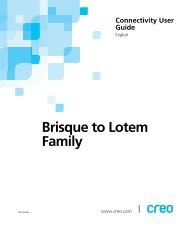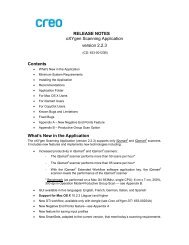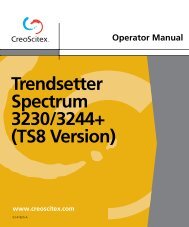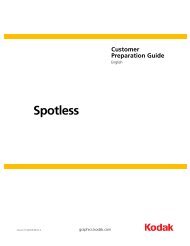Using Sample Calibration Curves with Copydot Toolkit - Kodak
Using Sample Calibration Curves with Copydot Toolkit - Kodak
Using Sample Calibration Curves with Copydot Toolkit - Kodak
Create successful ePaper yourself
Turn your PDF publications into a flip-book with our unique Google optimized e-Paper software.
CreoScitexCustomer SupportVancouver Response CenterTel: (604) 451-2727Toll-Free Tel: (800) 472-2727Fax: (604) 451-2713Toll-Free Fax: (888) 767-2736Customer Support Email:callcentre@creoscitex.com<strong>Using</strong> <strong>Sample</strong> <strong>Calibration</strong> <strong>Curves</strong> <strong>with</strong> <strong>Copydot</strong> <strong>Toolkit</strong>IntroductionThis technical bulletin provides an overview of what calibration curves are and how you can usethem <strong>with</strong> <strong>Copydot</strong> <strong>Toolkit</strong>. A procedure is provided using sample files to help you understandhow <strong>Copydot</strong> <strong>Toolkit</strong> calibration feature works. For a complete explanation of how to usecalibration <strong>with</strong> <strong>Copydot</strong> <strong>Toolkit</strong>, see the <strong>Copydot</strong> <strong>Toolkit</strong> User Guide (PDF included on the CD).What is a Harmony database file?The Harmony database file (.HMY) is the primary file type used by <strong>Copydot</strong> <strong>Toolkit</strong> for tonallycalibrating copydot data. Harmony database files are created <strong>with</strong> CreoScitex’s Harmonysoftware application and then imported into <strong>Copydot</strong> <strong>Toolkit</strong>. Each Harmony database filecontains specific calibration curve information. <strong>Calibration</strong> curves are used to control tonalreproduction of output files so that you can consistently match proofing or pressworkspecifications.What are calibration, current, and target curves?<strong>Calibration</strong> curves are derived from target and current curves. All three types of curves can beimported into the <strong>Copydot</strong> <strong>Toolkit</strong>.Current <strong>Curves</strong>Current curves are based on output you are producing now⎯that is, they indicate the resultsyou are currently achieving <strong>with</strong> your output device such as a proofer, press, etc. Currentcurves are created inside the Harmony application from dot area measurements recorded usinga densitometer.Target curvesTarget curves are based on what you want to achieve <strong>with</strong> your output device. For example, ifyou are calibrating to your halftone proofer, your target may be a customer proof or press sheet.The target curve is created inside the Harmony application from dot area measurementsrecorded using a densitometer.CreoScitex3700 Gilmore WayBurnaby, BCV5G 4M1 CANADATel: 1-604-451-2700www.creoscitex.com
<strong>Using</strong> <strong>Calibration</strong> <strong>Curves</strong> <strong>with</strong> <strong>Copydot</strong> <strong>Toolkit</strong>Technical BulletinPage 2 of 6<strong>Calibration</strong> <strong>Curves</strong>Once you have entered information for target and current curves, Harmony uses the informationto create a calibration curve (also referred to as a “derived” calibration curve). The calibrationcurve is stored inside the Harmony database file (.HMY) along <strong>with</strong> links to the target andcurrent curves from which it is derived.How to use calibration curves <strong>with</strong> the <strong>Copydot</strong> <strong>Toolkit</strong><strong>Copydot</strong> <strong>Toolkit</strong> doesn’t actually create calibration curves; it imports the curves or current andtarget curve data, from the Harmony database file. Since you do not have the Harmony softwareapplication, we have created a sample job <strong>with</strong> predefined calibration curves for you to test <strong>with</strong><strong>Copydot</strong> <strong>Toolkit</strong>. The procedure below describes how to apply and verify calibration curves onthe sample job.<strong>Calibration</strong> Workflow for Test<strong>Calibration</strong>2 Job (S Curve)Apply calibration curve to sample1. Select Test<strong>Calibration</strong>2 in the Job window.2. Click the Start Processing button in the Execution section.CreoScitex3700 Gilmore WayBurnaby, BCV5G 4M1 CANADATel: 1-604-451-2700www.creoscitex.com
<strong>Using</strong> <strong>Calibration</strong> <strong>Curves</strong> <strong>with</strong> <strong>Copydot</strong> <strong>Toolkit</strong>Technical BulletinPage 3 of 7Verify the calibrated output resultsNote: Your computer monitor must be set at 1600x1200 dpi to see the preview imageproperly in the Overview window. If your monitor does not support this resolution,the Overview window will be blank, but you can still navigate around the image.1. Click the Output button on the toolbar.2. Click the Ruler tool in the CreoScitex Image Viewer window.3. Click in the Image Viewer window, then place the “circle” cursor over the 75% Cyan tint stripat the bottom of the image. The Tint% indicated in the upper right corner should be 80%.4. Position the circle cursor over various (0.5 to 99.5%) tint strip columns for each color (i.e.C,M,Y,K) and compare the Tint% values indicated <strong>with</strong> those shown in Table 1 below.CreoScitex3700 Gilmore WayBurnaby, BCV5G 4M1 CANADATel: 1-604-451-2700www.creoscitex.com
<strong>Using</strong> <strong>Calibration</strong> <strong>Curves</strong> <strong>with</strong> <strong>Copydot</strong> <strong>Toolkit</strong>Technical BulletinPage 4 of 6Table 1: Calibrated Output Tint for Test<strong>Calibration</strong>2 JobTint Strip % Calibrated Output Tint %(ALL COLORS) (ALL COLORS)0.5 0.31 0.82 1.55 3.910 7.520 15.825 20.330 2540 36.350 5060 63.670 7575 8080 8490 92.295 96.298 98.499 99.299.5 99.7Each of the tint strip values measured in Step 4 for the Test<strong>Calibration</strong>2 job should matchthose in the Calibrated Output Tint % column. This indicates calibration was performedsuccessfully.CreoScitex3700 Gilmore WayBurnaby, BCV5G 4M1 CANADATel: 1-604-451-2700www.creoscitex.com
<strong>Using</strong> <strong>Calibration</strong> <strong>Curves</strong> <strong>with</strong> <strong>Copydot</strong> <strong>Toolkit</strong>Technical BulletinPage 5 of 65. Repeat the procedure for the Test<strong>Calibration</strong>1 job. The Cyan values in the Tint% column inthe upper right corner of the Image Viewer should match those shown in Calibrated OutputTint % column in Table 2 below.Table 2: Calibrated Output Tint for Test<strong>Calibration</strong>1 JobTint Strip %(CYAN)Calibrated Output Tint %(CYAN)0.5 0.61 1.42 2.45 4.410 10.220 20.825 26.230 31.440 40.350 49.360 59.970 68.775 74.180 78.990 90.695 96.498 98.799 99.499.5 99.7CreoScitex3700 Gilmore WayBurnaby, BCV5G 4M1 CANADATel: 1-604-451-2700www.creoscitex.com
<strong>Using</strong> <strong>Calibration</strong> <strong>Curves</strong> <strong>with</strong> <strong>Copydot</strong> <strong>Toolkit</strong>Technical BulletinPage 6 of 6The calibration curve for the Test<strong>Calibration</strong>1 job is designed for color-accurate proofing onCreoScitex's Spectrum devices. The diagram below outlines the workflow and the shape of thecurves used.<strong>Calibration</strong> Workflow for Test<strong>Calibration</strong>1 Job (Spectrum Curve)CreoScitex3700 Gilmore WayBurnaby, BCV5G 4M1 CANADATel: 1-604-451-2700www.creoscitex.com

















